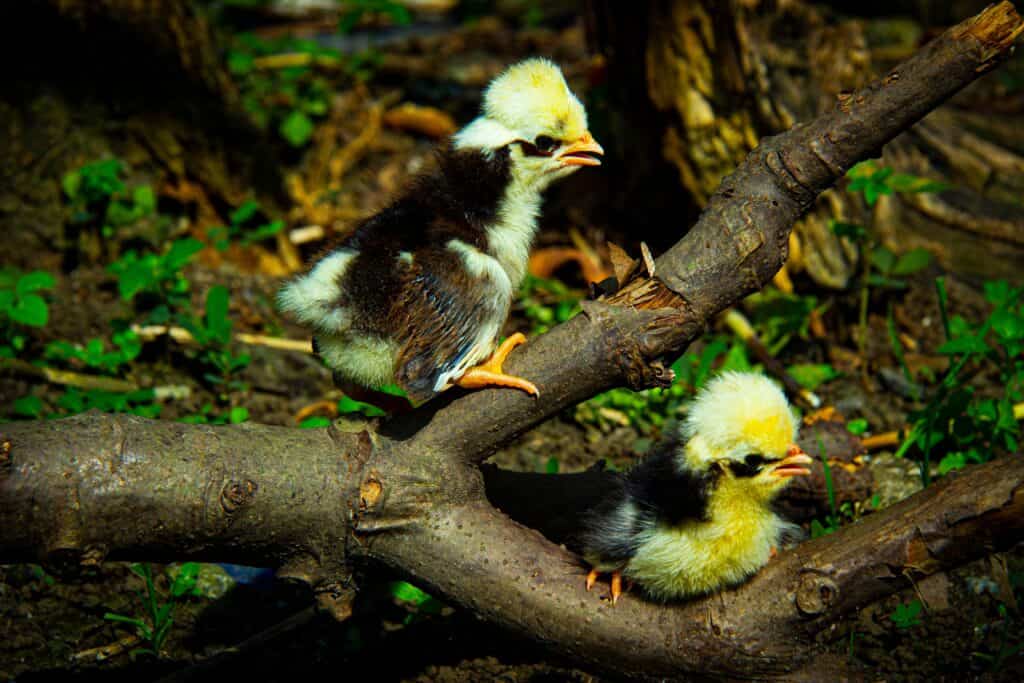The Polish chicken is a heritage breed known for its remarkable crest. This adornment earned this European breed the nickname tophat chicken. Once considered a prime egg layer, they are now bred as show birds or adopted as pets. Polish chickens are a tame breed, but can be timid and skittish at times since their showy head feathers can obstruct their vision and making them vulnerable. While males and females both possess impressive crests, they tend to display them differently. Let’s explore this and other differences between Polish roosters and hens.
Comparing a Male to a Female Polish Chicken
| Male Polish Chicken | Female Polish Chicken | |
|---|---|---|
| Size | 6 lbs | 4.5 lbs |
| Morphology | Unruly, tapered crest, Waddles develop and redden early, Narrow hackle feathers | Tidy, round crest, Waddles redden at sexual maturity, Round hackle feathers |
| Behavior | Friendly but can startle easily | Friendly but can startle easily, lay eggs |
| Vocalizations | Crow at maturity | Sometimes will crow, more likely to develop this call if raised with only females |
Male vs. Female Polish Chicken: Key Differences
Polish roosters and Polish hens differ in size, morphology, behavior, and vocalizations.
Determining the sex of newborn chicks is practically impossible without the expertise of a trained veterinarian or DNA testing. However, in a couple of weeks, differences begin to emerge that will let you know whether the Polish chicken in question is a rooster or a hen.
Male vs. Female Polish Chicken: Size
Polish roosters tend to be a bit larger than Polish hens, reaching an average of 6 pounds. Females weigh in at around 4.5 pounds.

Polish hens have tidy, round
pom-pomshaped head feathers toward the front of their head.
©Microfile.org/Shutterstock.com
Male vs. Female Polish Chicken: Morphology
Crest shape can help distinguish Polish roosters from Polish hens. Hens have tidy, round pom-pom shaped head feathers toward the front of their head. Roosters wear an unruly mop of long, tapered feathers located toward the back of their heads. In both sexes, the head crest is supported by a bony projection from the skull. This projection supports the enlarged brain of the Polish chicken in relation to other breeds.
Wattles and are the growths on a chicken head that are filled with veins and capillaries. Chickens don’t sweat, instead cooling themselves through blood circulation. Their blood is cooled as it passes through the combs/wattles. Polish chickens normally have a small combs, the v-shaped outgrowth on the top of their heads. Their wattles are small and often hidden by feathers. Though absent at birth, male chicks typically develop wattles before females, whose wattles are also slower to redden, but will turn bright red or pink once they have matured to egg-laying capacity, at about 4 to 9 months old.

Wattles and are the growths on a chicken head that are filled with veins and capillaries, as seen on this Polish
rooster
.
©cynoclub/Shutterstock.com
The shape of their hackle feathers can distinguish roosters from hens of all breeds, including Polish chickens. These neck feathers stand up when a chicken is feeling defensive to give them a bolder appearance. Hens have oval shaped hackle feathers, while roosters hackles are longer and thinner.
Male vs. Female Polish Chicken: Behavior
Only hens lay eggs. When attempting to determine the sex of your chickens, this is the only fool-proof method aside from DNA testing. They are not considered productive egg layers, laying roughly 120 eggs per year. Hens do not spend a lot of time brooding over their eggs. They tend to be quite playful and even cuddly, getting along well with their human caretakers, including children.
Polish roosters are similarly friendly. Both sexes are easily startled due to lack of visibility from their wild crests that may affect their ability to see clearly. Developing a whistle or other vocalization to announce your presence can reduce skittishness.

Determining the sex of newborn chicks is practically impossible without the expertise of a trained veterinarian or DNA testing.
©mulyo kurniawan/Shutterstock.com
Male vs. Female Polish Chicken: Vocalizations
All healthy Polish roosters will eventually crow. This rowdy call may also be produced by a hen if she is raised in an all-female flock. So, although crowing is a strong indicator of a chicken being male, it is not a foolproof method of distinguishing a male vs female polish chicken.
Though it is almost impossible to determine the sex of a Polish chick, differences will become more apparent as the chicks mature. Though they have differences in their crest, size, and laying habit, Polish roosters and Polish hens are a friendly breed that make good pets!
Up Next:
The photo featured at the top of this post is © cynoclub/Shutterstock.com
Sources
- science direct, Available here: https://www.sciencedirect.com/science/article/pii/S0032579119401442#bib7
- wikipedia, Available here: https://en.wikipedia.org/wiki/Polish_chicken
- serenitysprouts, Available here: https://www.serenitysprouts.com/chicken-sexing
Thank you for reading! Have some feedback for us? Contact the AZ Animals editorial team.






